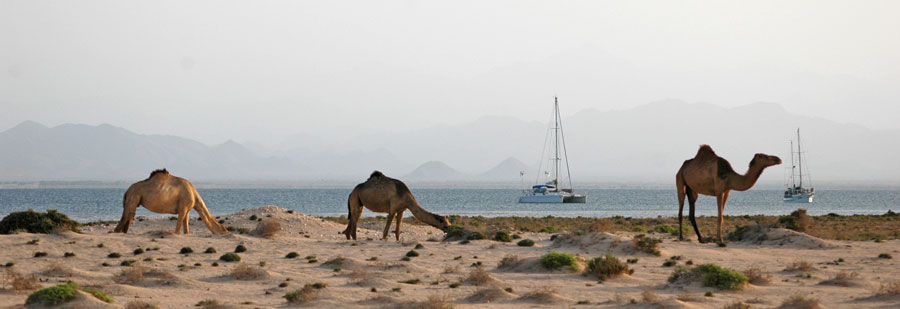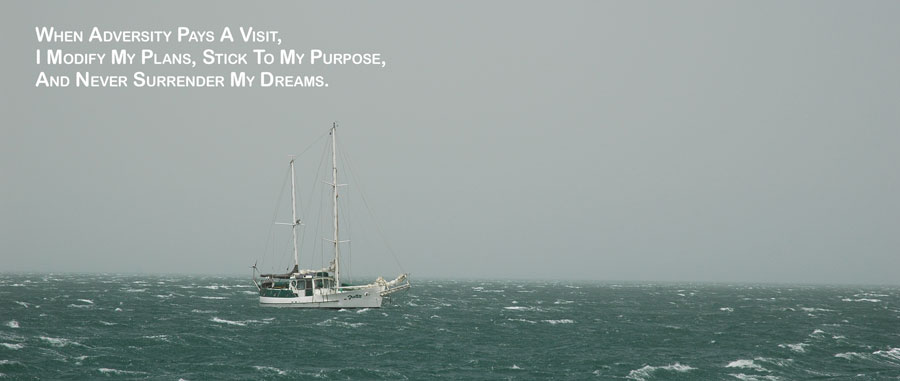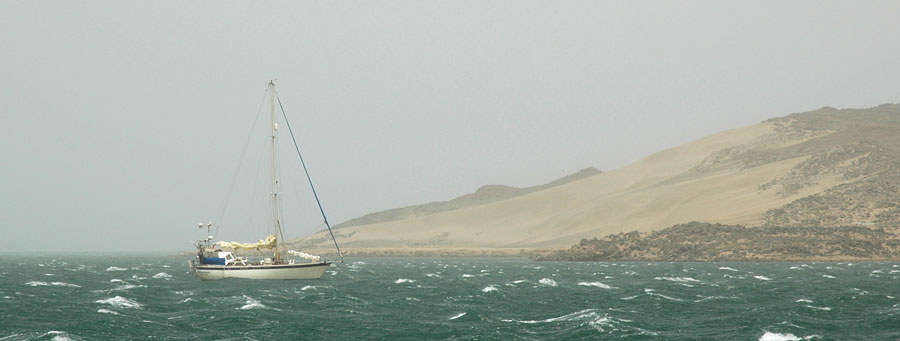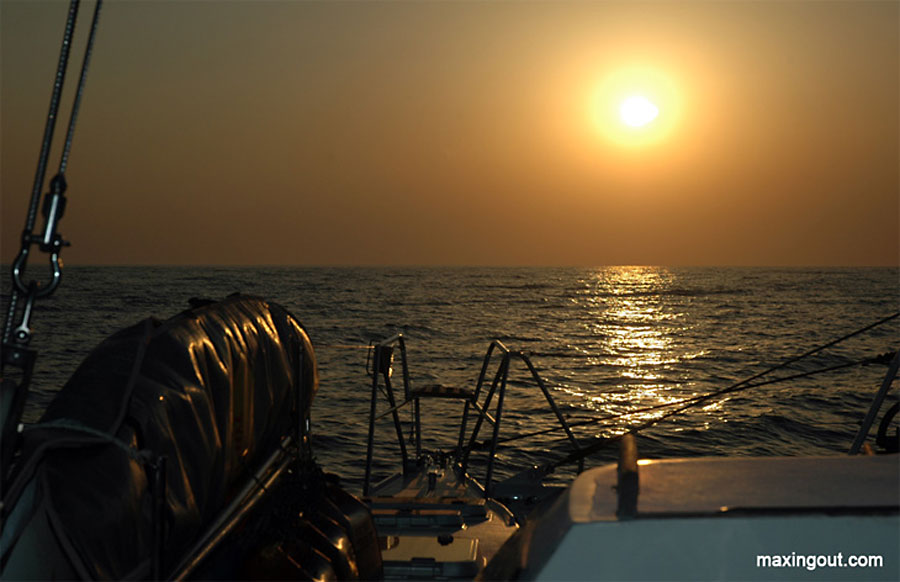|
RED SEA
RIGORS AND RUMORS
When the class of 2005 sailed through the Bab al Mandeb, we all had to
face the rigors and rumors of Red Sea cruising. As dozens of yachts
streamed cautiously north, we all wondered what the next six weeks would
bring.
The rumor mill constantly spewed forth piratical fantasies regarding
fishing boats that seemed all too curious about passing yachts.
Fortunately, the rumors turned out to only be rumors and nothing more.
All of the pirates had moved ashore and now specialized in other things.
The Red Sea rigors are a different story.
There are dozens of low lying islands, inlets, and reefs running along
the western shore. These are the stepping stones that make the voyage
into an awesome adventure. You can island hop up the Red Sea and enjoy
good snorkeling and deserted anchorages all along the way.

If you had to sail the Red Sea in a single go, you would have a battle
on your hands. Seven-hundred miles of strong headwinds rear their ugly
head to test your sails, rigging, and resolve. But smart sailors don't
do the Red Sea in one go. They arise early in the morning and move
their vessel thirty miles north before the headwinds start to blow. The
goal is to have the anchor down by noon in the next sheltered cove.
The trip north requires discipline and patience. When the headwinds
pipe up, patience is the order of the day. It's time to read books,
snorkel, or hike on the low lying islands. When the winds taper off,
discipline gets you up at sunrise, and you quickly get on your way.

Red Sea red tape was surprisingly benign. What could have been a
nightmare turned out to be routine. You don't need to reinvent the
wheel when checking in and out of countries. Officialdom has all the
paperwork ready to go and will help you fill it out if you have any
questions. In Eritrea, you deal directly with customs and immigration,
while in Egypt and Sudan, agents handle your paperwork for a nominal
fee.
The Red Sea transit turned out to be one of the most interesting,
enjoyable, and affordable parts of our circumnavigation. I speak Arabic
because I had worked in Arabia for eleven years as an eye surgeon, and
being able to communicate in Arabic made the trip more fun. I had
treated patients from all the countries bordering the Red Sea, and I
finally had the privilege of visiting the countries from where my
patients had come. Wherever we went, the people were gracious to us and
made us feel at home.

NEVER SURRENDER YOUR DREAMS
Take a look at the wind
and waves. The wind is blowing forty knots and Duetto, Balmacara, and
Exit Only are anchored at Ras Terma in Eritrea. There is a white out
from blowing sand lifted high into the air by a sandstorm. But at
least the anchors are down and holding, and we are no longer being
hammered by the seas of the Bab Al Mandeb.
Two
days earlier, we left Yemen and sailed through the Gulf of Aden until we
arrived at the Bab Al Mandeb which is the southern entrance to the Red
Sea. The Bab has a ferocious reputation because the winds in that area
frequently blow at fifty knots. Everyone sailing up the Red Sea must
run the boisterous gauntlet as they sail through the Bab.
When it was our
turn to sail those treacherous waters, we experienced first hand why the
the Bab al Mandeb is called the Gate of Sorrows. We pointed our bows
north, pushed open the Gate, and before long, we running downwind in a
fifty knot gale with turbulent steep seas crashing into our stern.
We went through
the Bab in the morning, and so we had plenty of daylight to work our way
north at about eight to ten knots. We hoped that if we got far enough
north, the winds would moderate, and the seas would lose their punch,
and we would have a more enjoyable and less risky sail up the Red Sea.
Unfortunately, the Bab showed us no mercy. The wind persisted at fifty
knots all day long, and it was apparent that it was going to be a long
night at sea if we didnít find shelter. We wanted to continue north as
fast as possible, but we also wanted to do it safely.

We had talked on
the radio with other people who had transited the Bab in similar
conditions, and they reported strong winds for up to thirty six hours.
That was bad news, and we didnít want to take a beating for that long.
Our other option was to head for Ras Terma, which was a deserted
anchorage behind a high headland in Eritrea about fifteen miles away.
We
decided to go to Ras Terma and hopefully ride out the strong winds in a
sheltered location. We tacked over on to a beam reach and headed for
land. I turned off the autopilot and steered by hand. I was afraid
that the wild seas might overpower the autopilot and strip its gears.
Hand steering the yacht for half a day in rough conditions was
inconvenient, but at least I would be sure to have an autopilot that was
working when the weather moderated. We needed the autopilot to
comfortably steer Exit Only for 1700 miles up the Red Sea.
It took three hours of extremely wet
sailing to arrive at Ras Terma. We were beam on to the steep seas, and
the waves that struck the side of the yacht relentlessly dumped gallons
of salt water over me as I steered at the unprotected helm. Each new
wave deposited more salt into my clothes until my shirt and pants became
stiff from the accumulation of salt. My clothes turned into a pillar of
salt.
Ras Terma proved to be a secure anchorage, but the
winds still blew at thirty-five to forty knots for at least a day and a
half before they abated. We hunkered down and waited for conditions to
improve. While we were anchored there, a sandstorm came through and
covered our boat with red desert dust. We shut up the boat to keep sand
from coming inside and creating a huge mess.
At least we had survived the Bab without damage.
Caked on salt spray mixed with desert dust is a small price to pay to
escape from the clutches of the Bab Al Mandeb. Once again, Exit Only
had proven that it was a strong and seaworthy vessel. It took a licking
and kept on ticking.
While itís true that adversity had paid visit, it
didnít move in and become a permanent member of our crew. We are
careful about such things. When adversity pays a visit, we modify our
plans, stick to our purpose, and never surrender our dreams.
Click on this
button to tell your friends about "Never Surrender Your Dreams".


RED SEA SUNSETS
I
didn't plan to sail up the Red Sea. It sort of happened by default.
My trip around the world in Exit Only took so long, I was hoping they
would have a Trans-African Canal completed by the time I arrived in the
Western Indian Ocean, but that turned out to be wishful thinking. In
the real world where I lived, I had only two choices. I could head
south into the deep southern ocean, visit Madagascar and South Africa,
and sail round the Cape of Good Hope into the Atlantic Ocean, or I could
sail up the dreaded Red Sea.
I knew that Exit Only could withstand the rigors of either trip if I was
careful. The southern route would be potentially dangerous because of
the weather; sailing in the southern ocean during winter is never fun.
The waters of the Mozambique Channel with its treacherous Agulhas
current is a graveyard for ships, and if you don't get it right, you
take a mighty beating. One of my friends flipped his monohull sailboat
upside down in that area. Fortunately, he and his boat survived with
minimal damage.
The northern route suffers mainly from political perils. The reefs and
headwinds of the northern Red Sea are manageable challenges, and as long
as there aren't any major foreign policy disasters working themselves
out during the trip, you can make the Red Sea transit without too much
difficulty.
I had to decide whether I wanted to see Red Sea sunsets or southern
ocean sunrises. All of our friends were sailing up the Red Sea, and so
we decided to go with the flow. It turned out to be a good decision,
because we survived, and survival is always good.
Our Red Sea Adventure took us to Oman, Yemen, Eritrea, Sudan and Egypt,
and in spite of the politics, we had a uniformly good trip. I speak
Arabic, and I'm sure that lubricated our passage through those
supposedly perilous waters. Wherever we went, people always treated us
with respect. We never felt threatened when on dry land; it was only at
sea in the Gulf of Aden that we had any major concerns. There's a
hundred mile long danger zone where Somali and Yemeni Pirates prey upon
passing ships and yachts. We teamed up with another yacht, Balmacara,
to make an uneventful radio silent passage through pirate alley. Not
all yachts were so lucky. Gandolf and Mahdi had a gun battle with
Yemeni pirates two days after we made our trip, and the pirates lost.
Several of the pirates went to paradise, or to wherever pirates go when
they die.
We didn't plan to go into Yemen, because the US Navy ship, the Cole, was
nearly sunk in Aden harbor. As it turned out, we had no choice but to
stop in Aden for refueling because diesel wouldn't be available again
until we were half way up the Red Sea in Sudan. There was a fuel
shortage in Eritrea, and the government wouldn't allow yachts to
purchase diesel at any price.
Aden turned out to be a nice surprise. We had total freedom of movement
in this former British protectorate. More than once, people walked up
to us on the street and spontaneously said, "Welcome to our country."
That had never happened to us before and hasn't happened since. Fuel
was cheap, food supplies were basic, but adequate, and the people were
lovely.
We made only one significant blunder on our trip up the Red Sea. We
unknowingly walked through a minefield on Difnein Island in Eritrea.
Next time I make the trip, I'll read the cruising guide before I go
ashore on remote islands, because that type of mistake can end in
disaster.
I worked as an eye surgeon for sixteen years
in Saudi Arabia at King Khalid Eye Specialist Hospital, and my patients
came from all the lands bordering on the Red Sea. The trip north gave
me an opportunity to visit the homelands of the people on whom I
performed surgery during all those years. I now had the privilege of
walking in their footsteps and seeing their towns and cities. What I
saw confirmed what I already knew. The overwhelming majority of them
are good people, and when you treat them with respect, they treat you
the same way.
We saw more than sixty sunsets as we sailed up the Red Sea. Because of
the dust in the air and paucity of clouds, an orange sunset frequently
greeted us at the end of the day. We saw the same type of sunsets when
we camped in Empty Quarter of the Arabian Peninsula.
Sailing up the Red Sea isn't for everyone, but it worked for us. If it
wasn't so far away, I would happily do it again without fear in my
heart. In spite of the negative media coverage of this region of the
world, it's a great place to cruise. If you like pristine diving,
wonderful people, and orange sunsets, the Red Sea is the place to be.
Even in the Red Sea, life is good.

TAKE THE PLUNGE AND
ORDER
THE RED SEA
CHRONICLES. JUMP INTO A
GREAT CATAMARAN CRUISING DVD. YOU WILL BE GLAD THAT YOU DID!
|